Citroën C3 2012 Owner's Manual
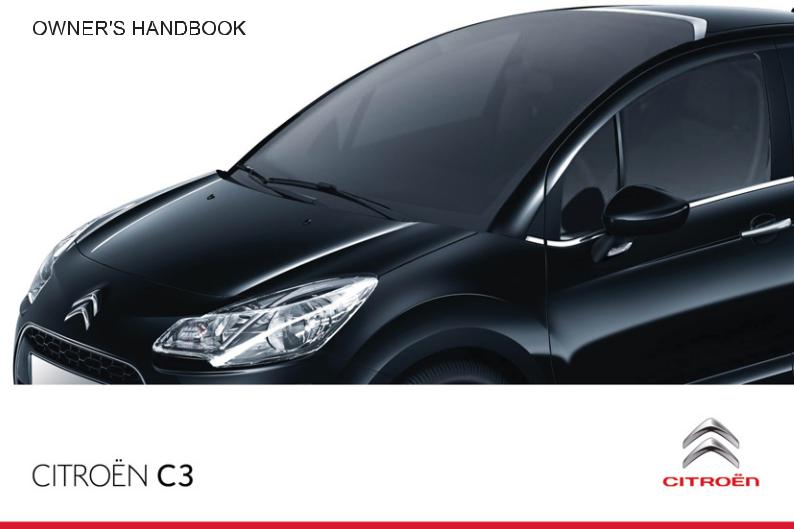
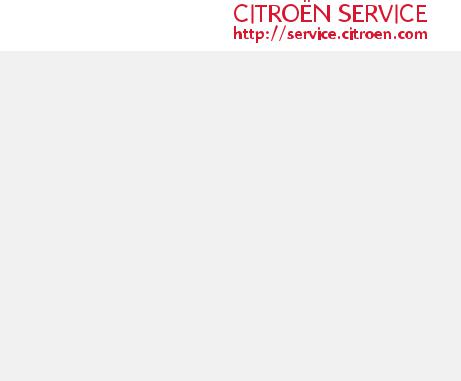
YOUR HANDBOOK ON THE INTERNET!
CITROËN lets you view your vehicle's documentation on line, to see earlier versions and the latest information, simply and free of charge.
Connect to http://service.citroen.com:
1Select your language and register,
2click on the link in the "Private customer access" zone to consult the vehicle documentation; a window opens providing access to all of the handbooks,
3select your vehicle, choose the body type then the date of issue of the handbook,
4finally, click on the heading of your choice.

We draw your attention to the following...
Your vehicle is fitted with only some of
the equipment described in this document, depending on the trim level, version and the specifications for the country in which it is sold.
The fitting of electrical equipment or accessories which are not recommended by CITROËN may result in a failure of your vehicle’s electronic system. Please note this specific warning and contact a CITROËN dealer to be shown the recommended equipment and accessories.
Key
 safety warning
safety warning
 additional information
additional information
 contributes to the protection of the environment
contributes to the protection of the environment
refer to the page indicated
CITROËN has a presence on every continent, a complete product range,
bringing together technology and a permanent spirit of innovation, for a modern and creative approach to mobility.
We thank you and congratulate you on your choice.
At the wheel of your new vehicle, getting to know each system, each control, each setting, makes your trips, your journeys
more comfortable and more enjoyable.
Happy motoring!
1

C O N T E N T S
FAMILIARISATION |
|
4 Î 20 |
3 - COMFORT |
50 Î 63 |
5 - VISIBILITY |
77 Î 85 |
|
|
|
|
|
|
|
|
|
|
|
|
Ventilation |
|
50 |
Lighting controls |
77 |
|
|
|
Heating |
|
52 |
Headlamp adjustment |
80 |
|
|
|
Manual air conditioning |
|
52 |
Wiper controls |
81 |
|
|
|
Digital air conditioning |
|
55 |
Courtesy lamps |
84 |
|
|
|
Rear screen demist - defrost |
57 |
Interior mood lighting |
85 |
|
|
|
|
Scented air freshener |
|
58 |
Boot lamp |
85 |
|
|
|
|
||||
ECO-DRIVING |
21 Î 22 |
Front seats |
|
59 |
|
|
|
Rear seats |
|
61 |
|
|
|||
|
|
|
|
|
|
||
|
|
|
Mirrors |
|
62 |
|
|
|
|
|
|
|
|
||
|
|
|
Steering wheel adjustment |
|
63 |
|
|
|
|
|
|
|
|
|
|
1 - MONITORING |
23 Î 42 |
4 - ACCESS |
64 Î 76 |
6 - FITTINGS |
86 Î 91 |
||
|
|||||||
|
|
|
|
|
|
|
|
Instrument panels |
|
23 |
Remote control key |
|
64 |
Interior fittings |
86 |
Indicator and warning lamps |
25 |
Window controls |
|
68 |
Boot fittings |
90 |
|
Indicators |
|
35 |
Doors |
|
70 |
|
|
Adjustment buttons |
|
38 |
Boot |
|
73 |
|
|
Trip computer |
|
40 |
Fuel tank |
|
74 |
|
|
|
|
|
Misfuel prevention (Diesel) |
|
76 |
|
|
2 - MULTIFUNCTION |
43 Î 49 |
SCREENS |
|
Monochrome screen A |
43 |
Monochrome screen C |
45 |
16/9 colour screen (MyWay) |
48 |
7 - CHILD |
92 Î 100 |
SAFETY |
|
Child seats |
92 |
ISOFIX child seats |
97 |
Child lock |
100 |
2

8 - SAFETY |
101 Î 109 |
|
|
|
|
Direction indicators |
|
101 |
Hazard warning lamps |
|
101 |
Horn |
|
101 |
Emergency or assistance call |
102 |
|
Braking assistance systems |
102 |
|
Trajectory control systems |
103 |
|
Front seat belts |
|
104 |
Airbags |
|
106 |
C O N T E N T S
10 - CHECKS |
129 |
Î 135 |
12 - TECHNICAL |
167 Î 178 |
|
DATA |
|||||
|
|
|
|||
Bonnet |
|
130 |
Petrol engines |
167 |
|
Running out of fuel (Diesel) |
130 |
Petrol weights |
168 |
||
Petrol engines |
|
131 |
LPG engines |
170 |
|
Diesel engines |
|
132 |
LPG weights |
171 |
|
Checking levels |
|
133 |
Diesel engines |
172 |
|
Checks |
|
134 |
Diesel weights |
174 |
|
|
|
|
Dimensions |
176 |
|
|
|
|
Identification markings |
177 |
|
9 - DRIVING |
110 Î 128 |
11 - PRACTICAL |
|
AUDIO and |
|
|
|
INFORMATION 136 Î 166 |
TELEMATICS |
179 Î 234 |
|||||
|
|
||||||
Parking brake |
110 |
Temporary puncture repair kit |
136 |
Emergency or assistance |
179 |
||
6-speed manual gearbox |
110 |
Changing a wheel |
141 |
MyWay |
|
181 |
|
Gear efficiency indicator |
111 |
Changing a bulb |
145 |
Audio system |
|
213 |
|
Electronic gearbox |
112 |
Changing a fuse |
151 |
|
|
|
|
Automatic gearbox |
116 |
Battery |
158 |
|
|
|
|
Stop & Start |
119 |
Energy economy mode |
160 |
|
|
|
|
Hill start assist |
122 |
Changing a wiper blade |
160 |
|
|
|
|
|
|
|
|||||
Speed limiter |
123 |
Towing the vehicle |
161 |
VISUALSEARCH |
235 Î 238 |
||
Cruise control |
125 |
Towing a trailer |
163 |
|
|
|
|
Rear parking sensors |
127 |
Audio pre-equipment |
164 |
|
|
|
|
|
|
Accessories |
165 |
|
|
|
|
|
|
|
|
|
|
|
|
|
|
|
|
ALPHABETICAL |
239 Î 242 |
||
|
|
|
|
INDEX |
|||
3
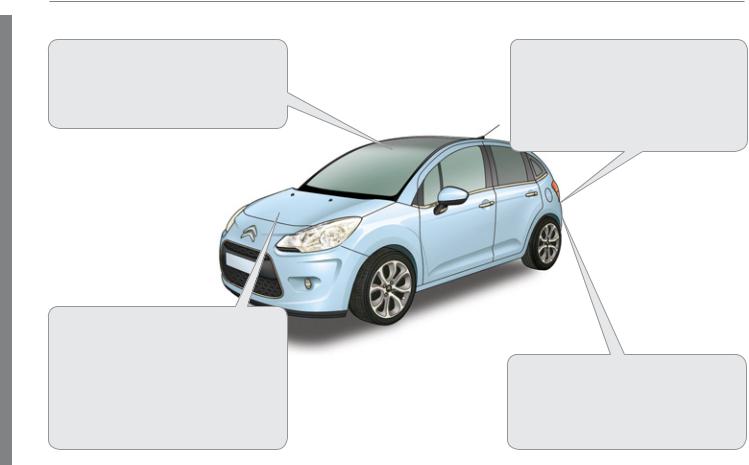
E X T E R I O R
Zenith windscreen
This large windscreen provides incomparable visibility and light in the passenger compartment.
6
Stop & Start
This system puts the engine temporarily into standby during stops in the traffic (red lights, traffic jams, etc...). The engine restarts automatically as soon as you want to move off. The Stop & Start system reduces fuel consumption, exhaust emissions and the noise level when stationary.
119
Temporary puncture repair kit
This kit is a complete system consisting of a compressor and sealant cartridge, to allow the temporary repair of a tyre.
136
Rear parking sensors
This system provides a warning when reversing by detecting obstacles located behind the vehicle.
127
4
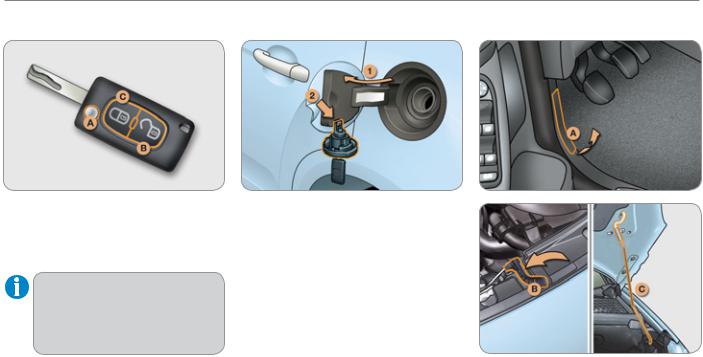
A C C E S S
Remote control key |
Fuel tank |
Bonnet |
A. Unfolding/Folding the key. |
1. Opening the fuel filler flap. |
B. Unlocking the vehicle. |
2. Opening and hooking the fuel filler |
|
cap. |
64 |
Tank capacity: |
|
|
Other functions... |
- approximately 50 litres (petrol), |
- approximately 46 litres (Diesel), |
|
C. Normal locking of the vehicle |
- (depending on version: approximately |
Vehicle location. |
30 litres (petrol or Diesel)). |
|
74 |
A. Interior release lever.
B. Exterior safety catch.
C. Bonnet stay.
130
F A M I L I A R I S A T I O N
5
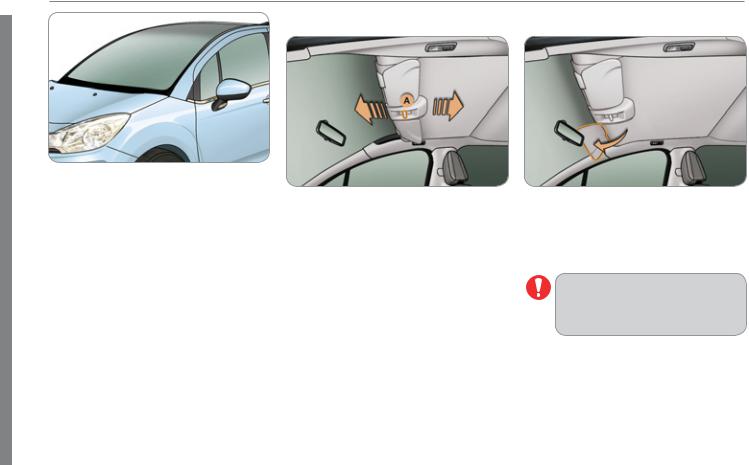
Z E N I T H W I N D S C R E E N
Blind |
Sun visors |
System comprising a panoramic tinted glass area to increase lighting and vision in the cabin.
Fitted with a manual blind to improve thermal comfort and sun visors to avoid dazzle.
)To open the blind, take it by its central grip A, then pull it backwards and guide it to the desired position.
)To close the blind, take it by its central grip A, then pull it forwards and guide it to the desired position.
Before moving the blind, the sun visors must be in the folded position.
) Lower the sun visors to avoid dazzle.
Do not attach or hang heavy objects to the blind or its guide rails.
6
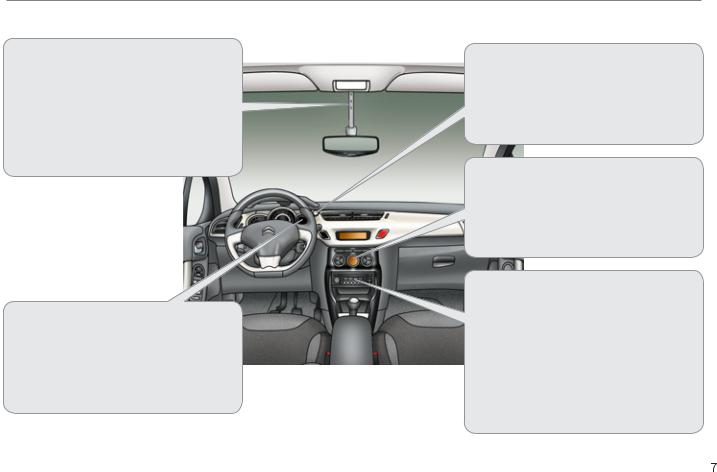
I N T E R I O R
Interior mood lighting
This subdued passenger compartment lighting improves visibility inside the vehicle in low lighting conditions. It comprises several lamps, located in the automatic day/night mirror support and in the lower dashboard storage compartment.
85
Gear shift indicator
Associated with the manual gearbox, this system suggests when to change up to obtain optimum fuel consumption.
111
Scented air freshener
The scented air freshener diffuses the selected fragrance throughout the passenger compartment from its location in the ventilation system.
58
Digital air conditioning
After setting the desired level of comfort, the system then automatically controls this level according to the ambient conditions.
55
Audio and communication systems
This equipment benefits from the latest technology: MP3 compatible Audio system, USB port, Bluetooth hands-free system, MyWay with 16/9 colour screen, auxiliary inputs, Hi-Fi audio system.
MyWay 181
Audio system 213
F A M I L I A R I S A T I O N
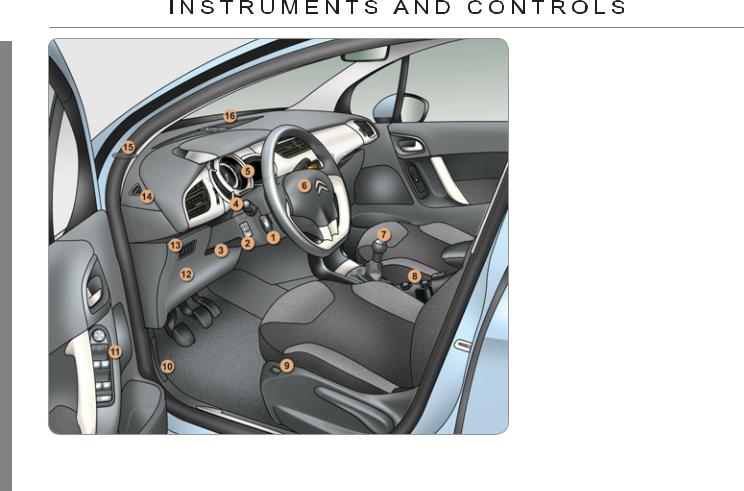
1. Cruise control/speed limiter switches.
2. Headlamp height adjustment.
3. Steering wheel adjustment control.
4. Lighting and direction indicators control stalk.
5. Instrument panel.
6. Driver's airbag.
Horn.
7. Gear lever.
8. 12 V accessory socket
USB port/auxiliary socket.
9. Heated seat control.
10. Bonnet release lever.
11. Door mirror controls. Electric window controls.
Rear doors and electric windows deactivation switch.
12. Fusebox.
13. Stop & Start switch
Electronic stability programme switch (ESP/ASR).
14. Front door window demisting/ defrosting vent.
15. Speaker (tweeter).
16. Windscreen demisting/defrosting vent.
8
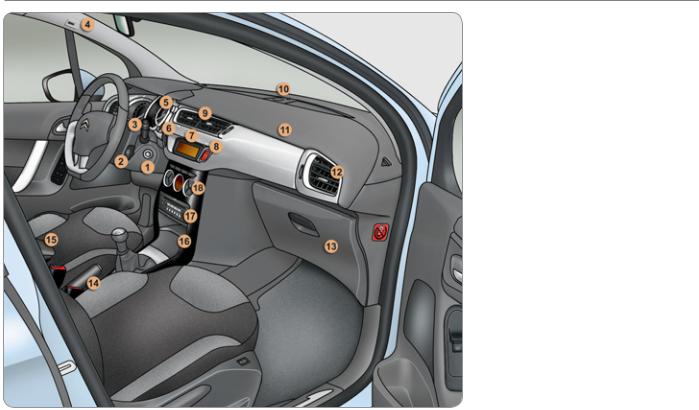
I N S T R U M E N T S A N D C O N T R O L S
1. Steering lock and ignition.
2. Audio equipment steering wheel controls.
3. Wipers/screenwash/trip computer control stalk.
4. Microphone.
5. Scented air freshener.
6. Central locking switch.
7. Multifunction screen.
8. Hazard warning lamps switch.
9. Central adjustable air vents.
10. Sunshine sensor
Hi-Fi audio system central speaker.
11. Passenger's airbag.
12. Side adjustable air vent.
13. Glove box/Passenger's airbag deactivation/Audio/video sockets.
14. Parking brake.
15. Central armrest with storage.
16. Upper and lower storage.
17. MyWay or Audio system.
18. Heating/air conditioning controls.
F A M I L I A R I S A T I O N
9
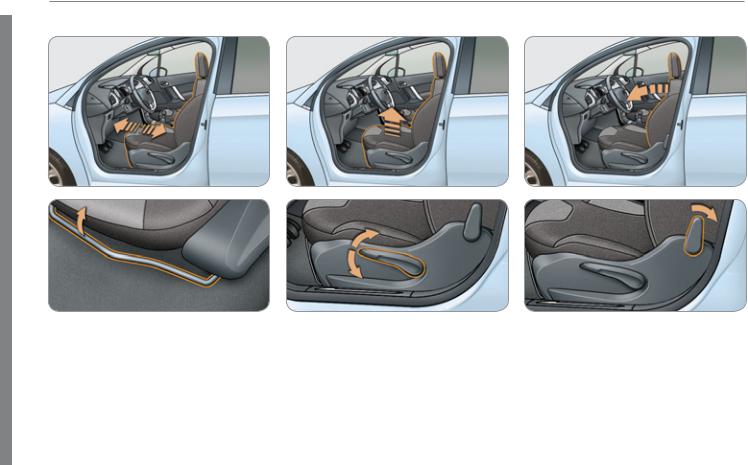
S I T T I N G C O M F O R T A B L Y
Front seats
1. Forwards-backwards adjustment. |
2. Height adjustment. |
3. Seat back angle adjustment. |
59
10
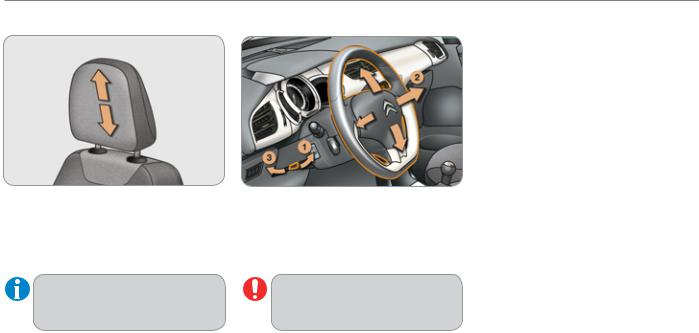
S I T T I N G C O M F O R T A B L Y
Other adjustments |
Steering wheel adjustment |
4. Head restraint height adjustment. |
1. Release the adjustment mechanism. |
|
2. Adjust the wheel for height and |
60 |
reach. |
3. Lock the adjustment mechanism. |
|
Other functions... |
For reasons of safety, these op- |
Heated seats. |
erations must only be carried out |
|
with the vehicle stationary. |
|
63 |
F A M I L I A R I S A T I O N
11
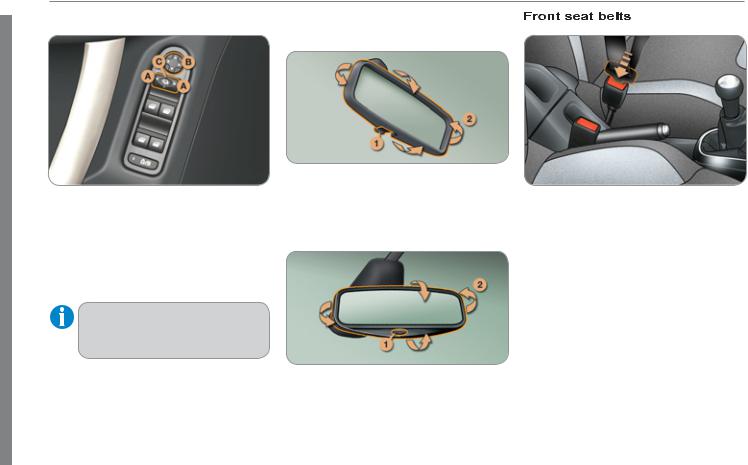
S I T T I N G C O M F O R T A B L Y
Door mirrors |
Rear view mirror |
Adjustment
A. Selecting the mirror.
B. Adjusting the position of the mirror.
C. De-selecting the mirror.
62
Other functions...
Folding/Unfolding.
Manual day/night type
1. Selecting the "day" position of the mirror.
2. Adjusting the mirror.
63
Automatic day/night type
1. Automatic detection of day/night mode.
2. Adjusting the mirror.
63
1. Fitting the belt.
2. Fastening.
3. Check that the belt is correctly fastened by pulling on the belt webbing.
104
12
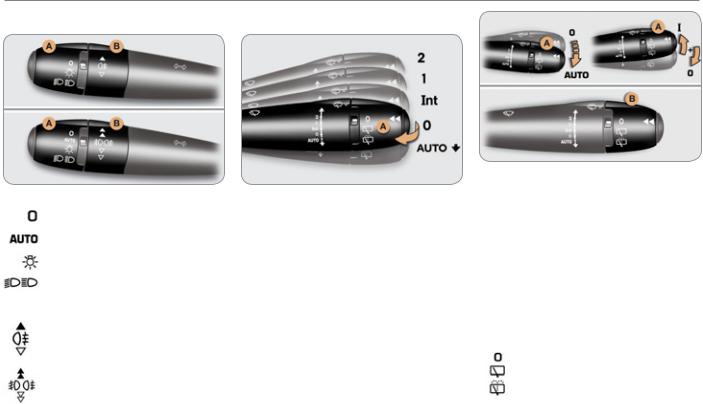
S E E I N G C L E A R L Y
Lighting |
Wipers |
Ring A
Lighting off.
Automatic illumination of headlamps.
Sidelamps.
Dipped/main beam headlamps.
Ring B
Rear foglamps.
or
Front and rear foglamps.
77
Control stalk A: windscreen wipers
2. Fast wipe.
1. Normal wipe.
Int. Intermittent wipe.
0. Park.
AUTO È Automatic wiping or single wipe.
Wash-wipe: pull the control stalk towards you.
81
Switching on "AUTO" mode
)Push the control stalk downwards and release it.
Switching off "AUTO" mode
)Push the control stalk upwards and return it to position "0".
83
Ring B: rear wiper
Park.
Intermittent wipe.
Wash-wipe.
82
F A M I L I A R I S A T I O N
13
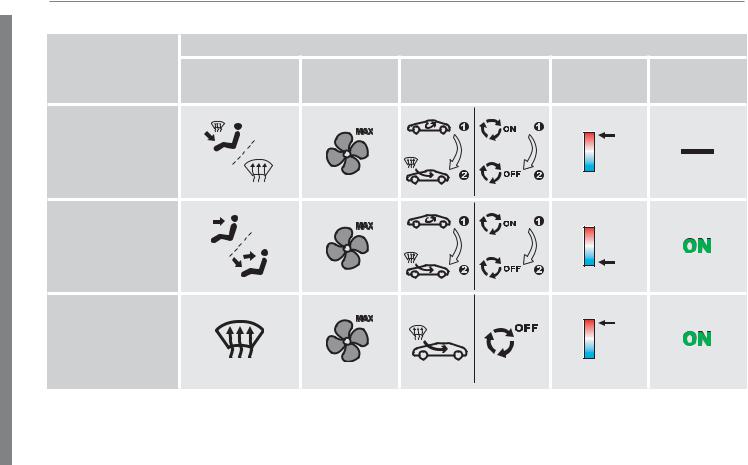
V E N T I L A T I O N
Advice on interior settings
Heating or Manual air conditioning
I require... |
|
Air recirculation/ |
|
|
|
Air distribution |
Air flow |
Temperature |
Manual A/C |
||
Exterior air intake |
|||||
|
|
|
|
||
HEAT |
|
|
|
|
|
COOL |
|
|
|
|
|
DEMISTING |
|
|
|
|
|
DEFROSTING |
|
|
|
|
Digital air conditioning: use of the fully automatic mode by pressing the "AUTO" button is recommended.
14

|
|
|
|
|
|
|
|
|
|
Instrument panel |
Warning lamps |
Switch panel |
||
A. With the ignition on, the fuel gauge bars for the fuel remaining should come on.
B. With the engine running, the associated low level warning lamp should go off.
C. With the ignition on, the oil level indicator should display "OIL OK" for a few seconds.
If the levels are not correct, top up the level which is low.
23
1. With the ignition on, the orange and red warning lamps come on.
2. With the engine running, these warning lamps should go off.
If a warning lamp remains on, refer to the page concerned.
25, 30
Illumination of the indicator lamp indicates the state of the corresponding system.
A. ESP/ASR system deactivation.
103
B. Stop & Start system deactivation.
120
F A M I L I A R I S A T I O N
15
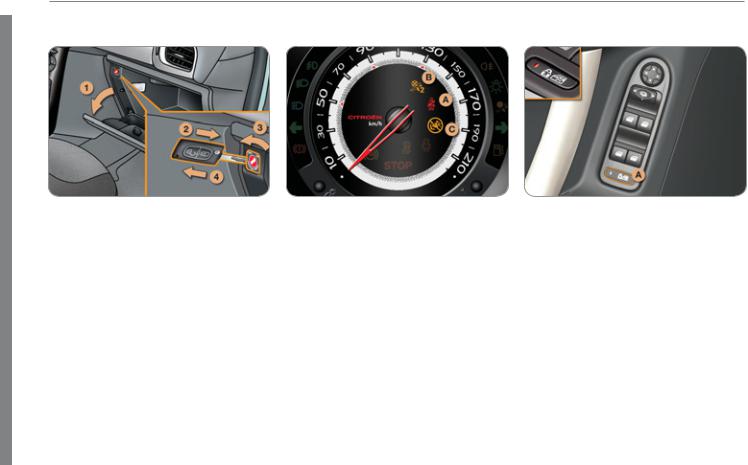
P A S S E N G E R S A F E T Y
Front passenger's airbag |
Front seat belts and |
Electric child lock |
|
passenger's front airbag |
|
1. Open the glove box.
2. Insert the key.
3. Select position:
"ON" (activation), with front passenger or "forwards facing" child seat,
"OFF" (deactivation), with "rear facing" child seat".
4. Remove the key keeping the switch in the new position.
107
A. Front seat belts not fastened or unfastened warning lamp.
104
B. Front passenger's airbag deactivation indicator lamp.
C. Front passenger's airbag activation indicator lamp.
107
Illumination of the lamp A indicates that the rear door and rear electric window controls are deactivated.
100
16
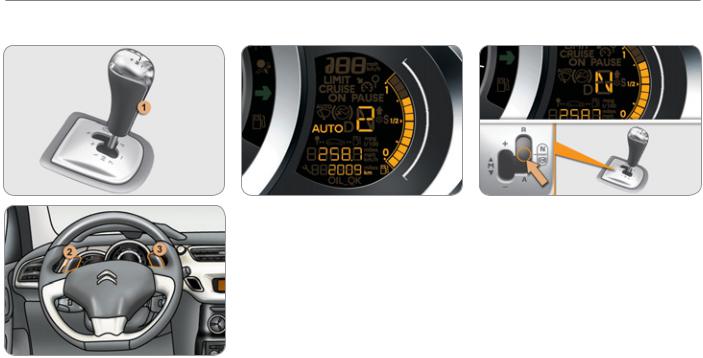
D R I V I N G S A F E L Y
Electronic gearbox |
Display in the instrument panel |
Starting and moving off |
5 or 6-speed electronic gearbox offering the choice of the comfort of automated operation or the pleasure of manual gear changing.
1. Gear lever.
2. Steering-mounted "-" control paddle.
3. Steering-mounted "+" control paddle.
The gear engaged or the driving mode selected appears in the instrument panel screen.
N. Neutral.
R. Reverse.
1 to 5/6. Gears engaged. AUTO. Automated mode.
) Select position N.
) Apply the foot brake firmly
) Start the engine.
)Select automated mode (position A) or manual mode (position M) by moving the gear lever 1,
or
engage reverse by pushing the gear lever 1 to the position R.
) Release the parking brake.
)Progressively take your foot off the brake pedal, then move off.
112
F A M I L I A R I S A T I O N
17
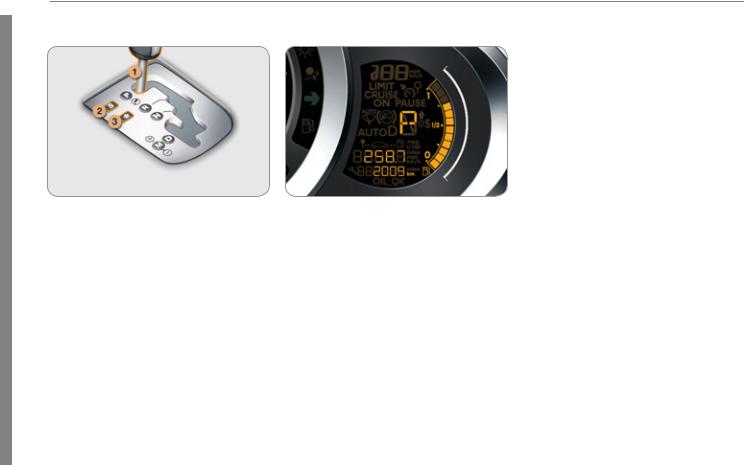
D R I V I N G S A F E L Y
Automatic gearbox |
Display in the instrument panel |
Starting and moving off |
This 4-speed gearbox offers the choice of the comfort of automatic operation or the pleasure of manual gear changing.
1. Gear lever.
2. "S" (sport) switch.
3. "7" (snow) switch.
The driving mode selected and/or the gear engaged appear in the instrument panel screen.
P. Park.
R. Reverse.
N. Neutral.
D. Drive (Automatic operation).
S. Sport programme. 7 Snow programme.
1 to 4. Gears engaged.
-. Invalid value in manual operation.
) Apply the parking brake.
) Select position P or N. ) Start the engine.
) Apply the foot brake.
) Release the parking brake.
) Then select position R, D or M.
)Progressively remove your foot from the brake pedal: the vehicle moves off on its own.
116
18
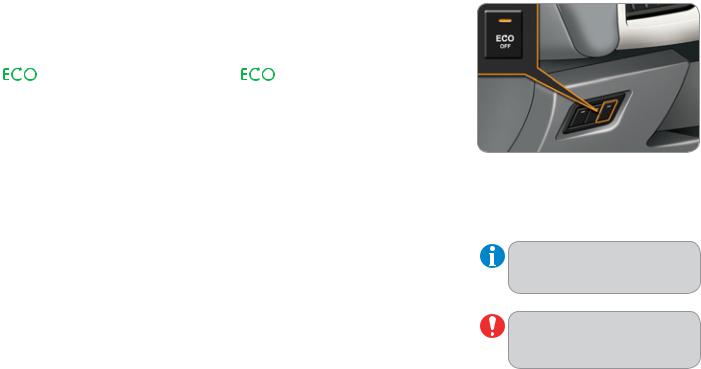
|
|
D R I V I N G S A F E L Y |
|
|
|
Stop & Start |
|
|
Going into engine STOP mode |
Going into engine START mode |
|
|
The "ECO" warning lamp comes |
The "ECO" warning lamp goes |
|
on in the instrument panel and |
off and the engine restarts: |
|
the engine goes into standby: |
|
- with a manual gearbox: at speeds |
- with a manual gearbox: when you |
|
|
below 12 mph (20 km/h), when you |
depress the clutch pedal, |
|
put the gear lever into neutral and |
|
|
you release the clutch pedal, |
|
-with a 5 or 6-speed electronic gearbox: at speeds below 5 mph (8 km/h), when you press the brake pedal or you move the gear lever to position N.
In some circumstances, STOP mode may not be available; the "ECO" warning lamp flashes for a few seconds, then goes off.
119
-with a 5 or 6-speed electronic gearbox:
●with the gear lever in position A or M, when you release the brake pedal,
●or with the gear lever in position N and the brake pedal released, when you put the gear lever in position A or M,
●or when you engage reverse.
In certain circumstances, START mode may be invoked automatically; the "ECO" warning lamp flashes for a few seconds , then goes off.
Deactivation/Reactivation
You can deactivate the system at any time by pressing the "ECO OFF" switch; the warning lamp in the button comes on.
The system is reactivated automatically every time the vehicle is started using the key.
Before refueling or doing anything under the bonnet, you must switch off the ignition with the key.
120 |
120 |
F A M I L I A R I S A T I O N
19
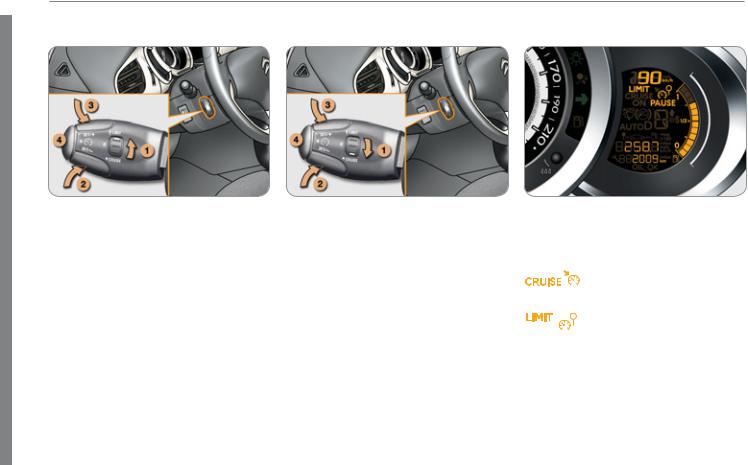
D R I V I N G S A F E L Y
Speed limiter "LIMIT" |
|
Display in the instrument panel |
|
1. Selecting/Switching off speed limiter mode.
2. Decrease the programmed value.
3. Increase the programmed value.
4. Speed limiter on/off.
The values must be set with the engine running.
123
1. Selecting/Switching off cruise control mode.
2. Decrease the programmed value.
3. Increase the programmed value.
4. Cruise control Off/Resume.
In order to be programmed or activated, the vehicle speed must be higher than 25 mph (40 km/h), with at least fourth gear engaged on a manual gearbox (second gear on an electronic or automatic gearbox).
125
The cruise control or speed limiter mode appears in the instrument panel when it is selected.
Cruise control
Speed limiter
20

E C O - D R I V I N G
Eco-driving is a range of everyday practices that allow the motorist to optimise their fuel consumption and CO2 emissions.
Optimise the use of your gearbox
With a manual gearbox, move off gently, change up without waiting and drive by changing up quite soon. If your vehicle has the system, the gear shift indicator invites you to change up; it is displayed in the instrument panel, follow its instructions.
With an automatic or electronic gearbox, stay in Drive "D" or Auto "A", according to the type of gearbox, without pressing the accelerator pedal heavily or suddenly.
Drive smoothly
Maintain a safe distance between vehicles, use engine braking rather than the brake pedal, and press the accelerator progressively. These practices contribute towards a reduction in fuel consumption and CO2 emissions and also helps reduce the background traffic noise.
If your vehicle has cruise control, make use of the system at speeds above 25 mph (40 km/h) when the traffic is flowing well.
Control the use of your electrical equipment
Before moving off, if the passenger compartment is too warm, ventilate it by opening the windows and air vents before using the air conditioning.
Above 30 mph (50 km/h), close the windows and leave the air vents open.
Remember to make use of equipment that can help keep the temperature in the passenger compartment down (sun roof and window blinds...).
Switch off the air conditioning, unless it has automatic digital regulation, as soon as the desired temperature is attained.
Switch off the demisting and defrosting controls, if not automatic.
Switch off the heated seat as soon as possible.
Switch off the headlamps and front foglamps when the level of light does not require their use.
Avoid running the engine before moving off, particularly in winter; your vehicle will warm up much faster while driving.
As a passenger, if you avoid connecting your multimedia devices (film, music, video game...), you will contribute towards limiting the consumption of electrical energy, and so of fuel.
Disconnect your portable devices before leaving the vehicle.
21

Limit the causes of excess consumption
Spread loads throughout the vehicle; place the heaviest items in the bottom of the boot, as close as possible to the rear seats.
Limit the loads carried in the vehicle and reduce wind resistance (roof bars, roof rack, bicycle carrier, trailer...). Use a roof box in preference.
Remove roof bars and roof racks after use.
At the end of winter, remove snow tyres and refit your summer tyres.
Observe the recommendations on maintenance
Check the tyre pressures regularly, when cold, referring to the label in the door aperture, driver's side.
Carry out this check in particular:
-before a long journey,
-at each change of season,
-after a long period out of use.
Don't forget the spare wheel and the tyres on any trailer or caravan.
Have your vehicle serviced regularly (engine oil, oil filter, air filter...) and observe the schedule of operations recommended by the manufacturer.
When refuelling, do not continue after the 3rd cut-off of the nozzle to avoid any overflow.
At the wheel of your new vehicle, it is only after the first 1 800 miles (3 000 kilometres) that you will see the fuel consumption settle down to a consistent average.
22
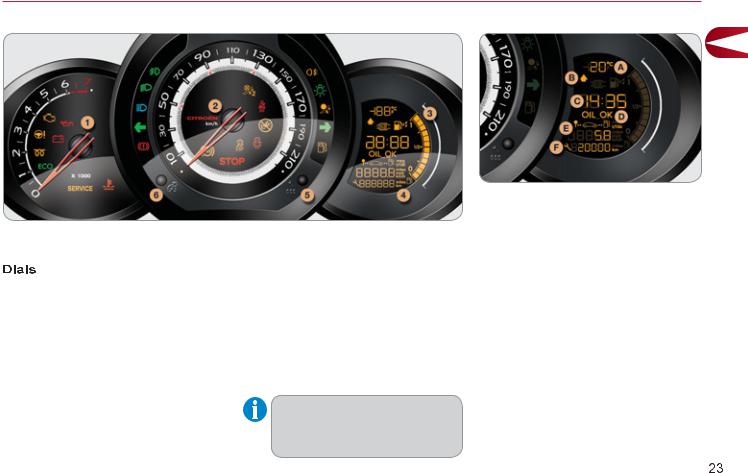
M O N I T O R I N G
PETROL - DIESEL MANUAL GEARBOX INSTRUMENT PANELS
Panel grouping together the vehicle operation indication dials and warning lamps.
1. Rev counter.
Indicates the speed of rotation of the engine (x 1 000 rpm).
2. Vehicle speed.
Indicates the current speed of the moving vehicle (mph or km/h).
3. Fuel level.
Indicates the quantity of fuel remaining in the tank.
4. Screen.
5. Display management button
Servicing information.
Adjust the time and choose units. Reset the service indicator.
6. Instrument panel lighting button.
Adjusts the brightness of the lighting of the instruments and controls.
For more information, refer to the section on the button or function and its associated display.
Screen
1
A. Ambient temperature.
(°Celsius or °Fahrenheit)
B. Gear shift indicator. C. Time.
D. Engine oil level indicator.
Appears a few seconds after switching on the ignition, then disappears.
E. Trip computer.
F. Service indicator.
(miles or km) then,
Total mileage.
These two functions are displayed successively when switching on the ignition.
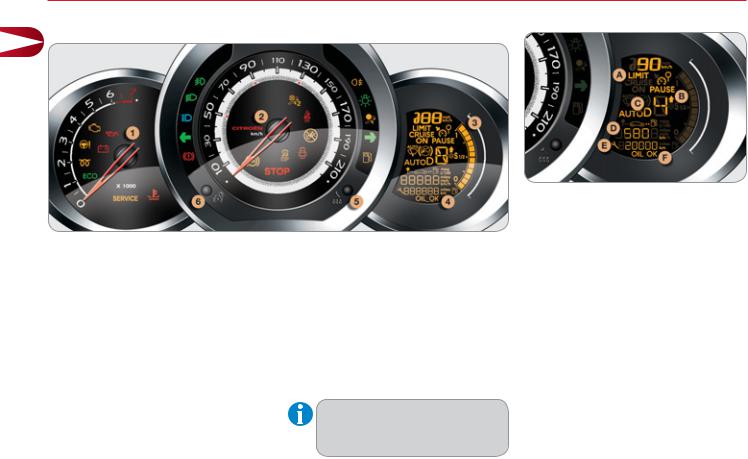
M O N I T O R I N G
INSTRUMENT PANELS FOR PETROL - DIESEL, MANUAL, 1 ELECTRONIC OR AUTOMATIC GEARBOXES
Panel grouping together the vehicle operation indication dials and warning lamps. Depending on the version, the instrument panel may have permanent back-lighting.
Dials |
5. Display management button |
|
1. Rev counter. |
Alternates display between range |
|
and trip mileage recorder. |
||
Indicates the speed of rotation of the |
Servicing information. |
|
engine (x 1 000 rpm). |
Resets the selected function to zero |
|
2. Vehicle speed. |
||
(trip distance recorder or service in- |
||
Indicates the current speed of the |
dicator). |
|
moving vehicle (mph or km/h). |
6. Instrument panel lighting button. |
|
3. Fuel level. |
Adjusts the brightness of the lighting |
|
Indicates the quantity of fuel remaining |
of the instruments and controls. |
|
in the tank. |
For more information, refer to the |
|
4. Screen. |
||
section on the button or function |
||
|
||
|
and its associated display. |
Screen
A. Speed limiter
(mph or km/h) or
Cruise control.
B. Gear shift indicator.
C. Electronic or automatic gearbox information.
D. Range
(miles or km) or
Trip mileage recorder. E. Service indicator
(miles or km), then
Total mileage recorder
These two functions are displayed successively when switching on the ignition
F. Engine oil level indicator
Appears a few seconds after switching on the ignition, then disappears.
24
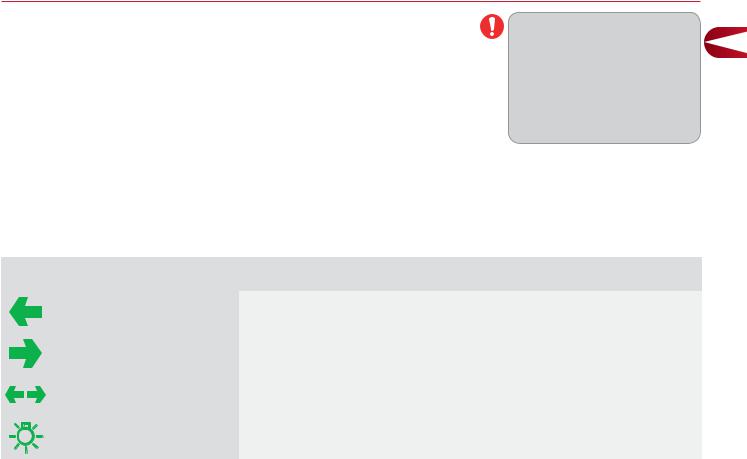
M O N I T O R I N G
Indicator and warning lamps
Visual indicators informing the driver that a system is in operation (operation or deactivation indicator lamps) or of the occurrence of a fault (warning lamp).
When the ignition is switched on
Certain warning lamps come on for a few seconds when the vehicle's ignition is switched on.
When the engine is started, these same warning lamps should go off.
If they remain on, before moving off, refer to the information on the warning lamp concerned.
Associated warnings
The illumination of certain warning lamps may be accompanied by an audible signal and a message in the multifunction screen.
Operation indicator lamps
If one of the following indicator lamps comes on, this confirms that the corresponding system has come into operation.
The warning lamps may come on continuously (fixed) or flash.
Certain warning lamps may |
1 |
come on in two different modes. |
Only by relating the type of illumination to the operating status of the vehicle can it be ascertained whether the situation is normal or whether a fault has occurred.
Warning lamp |
is on |
Cause |
Action/Observations |
|
|
|
|
|
|
|
Left-hand |
flashing with |
The lighting stalk is pushed |
|
|
direction |
|
||
|
buzzer. |
down. |
|
|
|
indicator |
|
||
|
|
|
|
|
|
|
|
|
|
|
Right-hand |
flashing with |
The lighting stalk is pushed |
|
|
direction |
|
||
|
buzzer. |
up. |
|
|
|
indicator |
|
||
|
|
|
|
|
|
|
|
|
|
|
Hazard |
flashing with |
The hazard warning lamps |
The left-hand and right-hand direction indicators |
|
switch, located on the |
and their associated indicator lamps flash |
||
|
warning lamps |
audible signal. |
||
|
dashboard, has been operated. |
simultaneously. |
||
|
|
|
||
|
|
|
|
|
|
Sidelamps |
fixed. |
The lighting stalk is in the |
|
|
"Sidelamps" position. |
|
||
|
|
|
|
|
|
|
|
|
|
25

M O N I T O R I N G
1 |
|
|
Warning lamp |
is on |
Cause |
Action/Observations |
||
|
|
|
|
|
|
|
||
|
|
Dipped beam |
|
The lighting stalk is in the |
|
|||
|
|
|
|
|
fixed. |
"Dipped beam headlamps" |
|
|
|
|
|
|
|
headlamps |
|
||
|
|
|
|
|
|
position. |
|
|
|
|
|
|
|
|
|
|
|
|
|
|
|
|
|
|
|
|
|
|
|
|
|
Main beam |
fixed. |
The lighting stalk is pulled |
Pull the stalk to return to dipped beam |
|
|
|
|
|
headlamps |
towards you. |
headlamps. |
|
|
|
|
|
|
|
|||
|
|
|
|
|
|
|
|
|
|
|
|
|
|
Front |
fixed. |
The front foglamps are |
Turn the ring on the stalk rearwards twice to |
|
|
|
|
|
foglamps |
switched on. |
switch off the front foglamps. |
|
|
|
|
|
|
|
|||
|
|
|
|
|
|
|
|
|
|
|
|
|
|
Rear |
fixed. |
The rear foglamps are |
Turn the ring on the stalk rearwards to switch off |
|
|
|
|
|
foglamps |
switched on. |
the rear foglamps. |
|
|
|
|
|
|
|
|||
|
|
|
|
|
|
|
|
|
|
|
|
|
|
|
|
|
Wait until the warning lamp goes off before |
|
|
|
|
|
|
|
|
starting. |
|
|
|
|
|
Diesel engine |
|
The ignition switch is at the |
The period of illumination of the warning lamp is |
|
|
|
|
|
fixed. |
determined by the climatic conditions (up to about |
||
|
|
|
|
|
pre-heating |
2nd position (ignition on). |
thirty seconds in extreme climatic conditions). |
|
|
|
|
|
|
|
|||
|
|
|
|
|
|
|
|
If the engine does not start, switch the ignition off |
|
|
|
|
|
|
|
|
and then on, wait until the warning lamp goes off |
|
|
|
|
|
|
|
|
again, then start the engine. |
|
|
|
|
|
|
|
|
|
|
|
|
|
|
|
|
|
Release the parking brake to switch off the |
|
|
|
|
|
|
|
The parking brake is |
warning lamp, keeping your foot on the brake |
|
|
|
|
|
|
|
pedal. |
|
|
|
|
|
|
Parking brake |
fixed. |
applied or not properly |
Observe the safety recommendations. |
|
|
|
|
|
|
|
released. |
|
|
|
|
|
|
|
|
For further information on the parking brake, refer |
|
|
|
|
|
|
|
|
|
|
|
|
|
|
|
|
|
|
to the "Driving" section. |
|
|
|
|
|
|
|
|
|
|
|
|
|
|
|
|
|
|
|
|
|
|
|
|
|
|
|
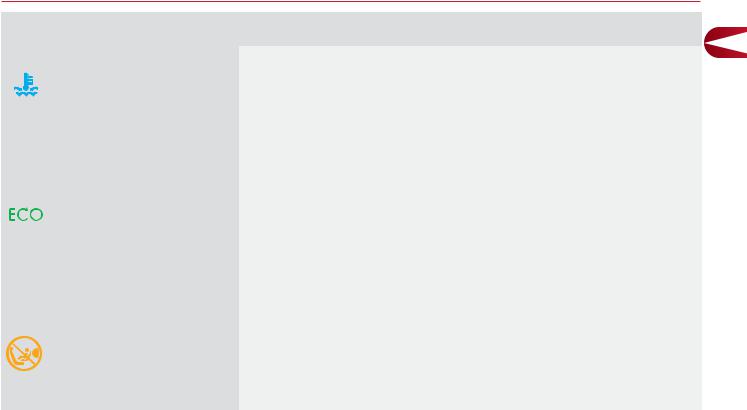
M O N I T O R I N G
Warning lamp |
is on |
Cause |
Action/Observations |
1 |
|
|
|
|
|
|
|
|
Engine |
|
On starting the engine, |
After a few minutes driving, it swiches off to |
|
|
|
|
|||
|
fixed blue. |
indicate that the engine temperature is normal. |
|
||
|
coolant |
it indicates that the engine |
In order to protect your engine, avoid driving too |
|
|
|
temperature |
|
is cold. |
|
|
|
|
hard until the warning lamp has switched off. |
|
||
|
|
|
|
|
|
|
|
|
|
|
|
|
|
|
When the vehicle stops (red |
The warning lamp goes off and the engine |
|
|
|
fixed. |
lights, traffic jams, ...) the |
|
|
|
|
Stop & Start system has |
restarts automatically in START mode, as soon |
|
|
|
|
|
put the engine into STOP |
as you want to move off. |
|
|
|
|
mode. |
|
|
|
Stop & Start |
|
|
|
|
|
|
STOP mode is temporarily |
|
|
|
|
|
|
|
|
|
|
|
flashes for a |
unavailable. |
Refer to "Driving - § Stop & Start" for special |
|
|
|
few seconds, |
or |
|
|
|
|
cases with STOP mode and START mode. |
|
||
|
|
then goes off. |
START mode is invoked |
|
|
|
|
|
|
||
|
|
|
automatically. |
|
|
|
|
|
|
|
|
|
|
|
The control switch, located |
|
|
|
|
|
in the glove box, is in |
Turn the control switch to the "OFF" position |
|
|
Passenger's |
|
the "ON" position. |
|
|
|
fixed. |
to deactivate the front passenger's airbag. |
|
||
|
airbag |
The passenger's front |
In this case you can install a rear-facing child |
|
|
|
system |
|
airbag is activated. |
|
|
|
|
seat. |
|
||
|
|
|
In this case, do not install a |
|
|
|
|
|
|
|
|
|
|
|
rear-facing child seat. |
|
|
|
|
|
|
|
|
27
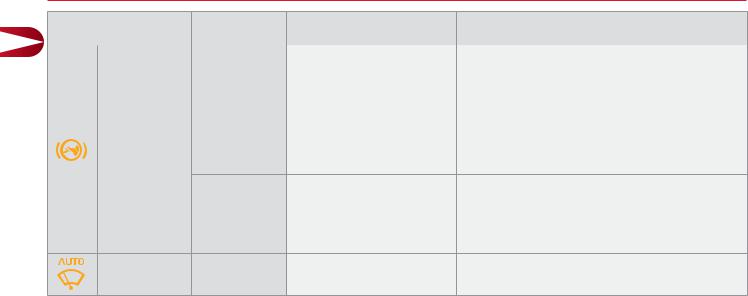
M O N I T O R I N G
1 |
Warning lamp |
is on |
Cause |
Action/Observations |
|
|
|
|
|
|
|
|
With an electronic gearbox, press the brake |
|
|
|
|
|
|
|
|
|
|
pedal to start the engine (lever in position N). |
|
|
|
|
With an automatic gearbox, with the engine |
|
|
|
The brake pedal must be |
running, press the brake pedal before releasing |
|
|
fixed. |
the parking brake, to unlock the lever and come |
|
|
|
pressed. |
||
|
|
|
out of position P. |
|
|
|
|
|
|
|
Foot on the |
|
|
If you wish to release the parking brake without |
|
|
|
pressing the brake pedal, this warning lamp will |
|
|
brake pedal |
|
|
remain on. |
With an electronic gearbox, if you hold the
flashing. vehicle on an incline using Use the brake pedal and/or the parking brake. the accelerator for too long,
the clutch overheats.
Automatic |
fixed. |
The wiper control is pushed |
Automatic front wiping is activated. |
|
wiping |
downwards. |
|||
|
|
28
